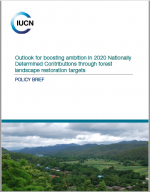Increasing ambition on NDCs through FLR
While countries have broadly recognised the role of forests and land-based action in climate change mitigation and adaptation in their Nationally Determined Contributions (NDCs), this ambition is often not fully reflected in the targets they set. As governments review their NDCs under the Paris Agreement, IUCN helps countries realise opportunities to increase their ambition through forest landscape restoration (FLR).
2020 marks a significant milestone for the Paris Agreement as countries have the opportunity to examine their current NDCs, including contributions from the agriculture, forestry and land use (AFOLU) sector. Land-use based emissions are substantial for most countries and are estimated to contribute 23% of total net global anthropogenic greenhouse gas emissions. However, investing in the AFOLU sector through nature-based solutions (NbS) increases resilience to climate change and capacity to function as a carbon sink, and provides countries with a strong path to achieve their climate goals.
Thirty-three countries have signalled their intention to update their NDCs, and 103 countries have stated their intention to enhance ambition or action in 2020 NDCs. Enhancing and updating NDCs by mainstreaming NbS from the AFOLU sector will pave the way for cost-effective actions to tackle both climate mitigation and adaptation — particularly as it is estimated to be able to deliver one-third of the mitigation needed through 2030 to stabilise global warming to below 2 °C.
This policy brief provides an outlook of AFOLU sector targets and actions in the first round of NDCs, highlighting the opportunity for FLR to be scaled up as a climate mitigation and adaptation measure to enhance current NDCs and make the forest and land-based targets more robust, ambitious and measurable for clarity and transparency. The findings are based on an analysis of FLR-aligned targets across NDCs and comparing these with opportunities from the existing Bonn Challenge voluntary pledges, related to:
- Robustness and measurability of FLR-aligned quantitative and qualitative targets and non-targets.
- Scope of FLR-aligned targets for accounting purposes: whether they are conditional, unconditional, economy-wide or sectoral targets.
- Mitigation or adaptation approaches and conditionality in FLR-aligned targets.
Key findings and opportunities
Findings on quantitative vs. qualitative targets: 130 out of 168 NDCs (77%) have quantitative and/or qualitative FLR-aligned targets. However, only 50 NDCs (30%) have quantitative FLR-aligned targets for mitigation and/or adaptation, representing 57 million hectares.
Opportunity: Integrate existing quantitative restoration commitments under the Bonn Challenge in the 2020 NDC update cycle. For example, if all Bonn Challenge countries were to incorporate their voluntary Bonn Challenge commitments into their 2020 NDCs, 210 million hectares of increased climate ambition could be generated from the AFOLU sector. Out of 168 NDCs, 61 are from Bonn Challenge countries with voluntary pledges totalling 205.78 million hectares. However, only 27 Bonn Challenge countries' NDCs have quantitative FLR-aligned targets for mitigation and/or adaptation for a total of 25 million hectares. These countries' voluntary pledges under the Bonn Challenge are more than double of what they included in their NDCs (54 million).
Findings on robustness and measurability of targets: 96 NDCs express their FLR-aligned targets as part of an economy-wide or multi-sectoral approach. Although 60 NDCs include sectoral AFOLU targets (quantitative or qualitative), 40 NDCs exclude the land-sector from the greenhouse gas accounting perspective. The majority of FLR-aligned targets lack references to the level of ambition and accounting method. For example, only 46 NDCs express targets in hectares, and 16 countries define forest targets in tCO2eq.
Opportunity: Decrease the level of uncertainly and ambiguity in current NDCs and enhance the clarity, robustness and transparency of the mitigation targets from the AFOLU sector. For example, if all hectare-based commitments under the Bonn Challenge were translated to tCO2eq, it would significantly increase the accountable AFOLU-based ambition in NDCs. Only 38 Bonn Challenge countries' NDCs express their target as part of an economy-wide or multi-sectoral approach. In the Bonn Challenge Countries' NDCs with quantified land-based targets, 20 countries define forest targets in hectares and 9 of them in tCO2eq. These targets represent a small portion of the total opportunity when compared to those voluntary commitments under the Bonn Challenge. Countries need to add quantitative elements to their targets in hectares or in tCO2eq where such enhancement can facilitate accounting of global emissions, comprehensive tracking of collective progress, access to result-based finance, and other opportunities.
Findings on conditionality of targets: The vast majority of quantitative FLR targets are also conditional. 64 of the 130 NDCs with FLR-aligned targets (quantitative and qualitative) have unconditional targets, and 88 have conditional targets, from which about 25 million hectares are unconditional targets, versus almost 32 million hectares that are conditional; 53.6 million tCO2eq are unconditional, and another 3.2 billion tCO2eq are conditional. This makes NDC implementation uncertain and ambiguous.
Opportunity: Reduce the conditionality of Bonn Challenge countries’ NDCs by fully integrating and quantifying countries’ planned FLR activities. Bonn Challenge countries' NDCs have about 1.07 million hectares in unconditional targets and 24 million hectares in conditional targets. Yet, under the Bonn Challenge, the same number of countries (n=20) has committed to 54 million hectares.

